Raising Bumble Bees
Having pollinators in your yard and garden is both a beneficial thing, it helps your veggies and flowers grow seeds, but its also just a lovely thing to watch. Raising honey bees and managing hives though is a huge commitment for most people. Luckily there is an alternative, which is fun and suited for Green Wizards.
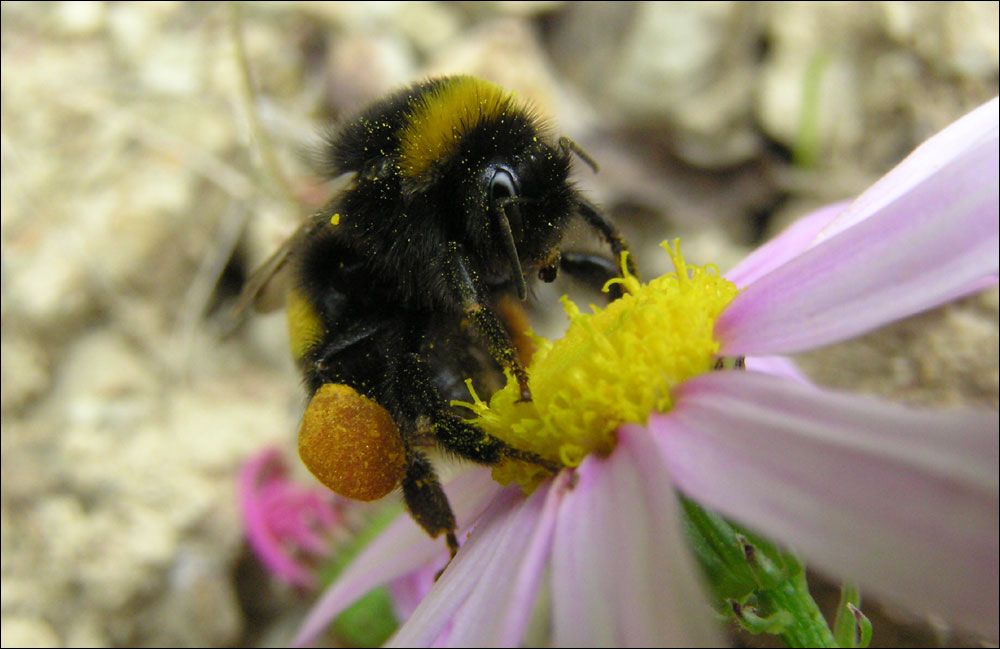
(copyright "I, Tony Willis, Wikimedia Commons)
Native bees, can be successfully encouraged to live in your garden with a little care and some resources they can use. Which can go a long way to bringing back needed biodiversity and helping pollinators in general. And unlike domesticated honey bees, it require a lot less time. You just need to learn a bit about their needs, how they live and their life cycle through the year. Bumble bees are especially useful due to their size. They can "buzz pollinate" vegetables like tomatoes, peppers and potatoes, which are not as easily pollinated by smaller insects.
An additional benefit of bumble bees as local pollinators, they don't appear to be affected by the colony collapse syndrome currently harming honey bees.
All in all having a bumble bee hive in your garden is a very useful thing. Let's get started then.
An Brief Introduction To Bumble Bees
(Wikipedia entry for Bumble Bees)
There are some 16,000 species of bees across the World, the majority of those do not live in hives. They are typically solitary and make their homes in small tunnels in the ground or in dead branches and sticks. While not as well known as their honey making cousins, these "wild" bees play a vital part in pollinating our food crops, our flowers and all the rest of the plant kingdom around us. Providing resources like a bit of bare ground left undisturbed, or leave and brush piles is critical to their survival.
Did you know that the tiny well known insect we call a "sweat bee" and which is often mistaken for a hover fly, is actually a bee? Halictidae is the second largest family of bees. Who hasn't sat in a garden while a few of these harmless insects look for moisture on our arms? Other species have just as fascinating a story.
The bumble bee though is most people's favorite. This gentle giant can be easily spotted going about its day, visiting flowers and harvesting pollen. Often confused with the similar sized carpenter bee, the difference is easily seen. Just look at their butts. Bumble bees have a fuzzy hairy butt, while the carpenter bee has one that is hairless and shiny.
Bumble bees are of the social side of the bee family, forming colonies around a single queen. These colonies are small compared to their honey bee cousins, typically only 30-50 individuals, though some species can have as many as 1700. In comparison, honey bees might have as many as 50,000. Bumble bees usually find a protected space to inhabit like a spot under your house siding or in a small borrow in the ground, rather than building a prominent hive in a tree. They feed on nectar from flowers and collect both nectar and pollen to return to the hive to feed the queen and the young.
Fun Fact: Bumble bees while normally not aggressive can sting if they feel threatened. Unlike honey bees, a bumble bee's stinger lacks barbs, so it can sting repeatedly.
One advantage to having bumble bees in your garden is their thick coat of bristles acts as insulation, so they can venture out when their cousin honey bees will remain in their hives. Honey bees also don't fly in temperatures below 55°F (12.8°C), nor will they fly in winds above 20 to 25 mph (32 to 40 kph), or when it is raining or even drizzling. This is helpful for earlier season plants as well as those in later Fall. Some professional growers even establish bumble bee hives in their green houses because they are such strong pollinators. They are some of the first pollinators to emerge in the Spring which makes them especially useful for Green Wizards.
They are also "erratic" flyers, in that their flight path when foraging will move around to many locations. Honey bees on the other hand, tend to be straight line row foragers concentrating their efforts in patches of density. For small gardens with many types of plants, having a erratic resident can mean more plants get pollinated. Who knew that a bit of aimlessness was so useful? This characteristic is especially useful if you plan on having them in a green house. Honey bees will often leave the green house for bigger patches of flowers, ignoring the plants inside the green house. Bumble bees in contrast will go for the nearby and available resource.
Bumble Bee Life Cycle

(copyright University of Wisconsin - Madison)
The life of a bumble bee queen actually begins the year before. In the Fall usually in August or September, the older queen will begin laying eggs which will develop into male drones and queen eggs. The males once grown will be driven from the hive to live solitary lives seeking mates. The young queens once grown will also leave the hive. They will seek out the males and copulate with one or more. They will then spend time eating lots of nectar and building up their reserves before finding a safe space to hibernate over the Winter.
Fun Fact: It is often these solitary young queens and male drones you see sleeping in flowers.
In the Spring usually late April or early May, these young queens will emerge and begin looking for a likely spot to build their new hive. Its at this time you can trap and domesticate a bumble bee for your garden (more on that is a bit). She will forage for pollen and nectar to bring back to the hive, then when ready lay her first crop of eggs called a "brood clump". Until this first set of workers has grown to adults, the young queen must forage for food, incubate the larvae and defend the hive. Once the new workers have transformed into adults the queen will remain in the nest for the rest of her life.
During the rest of her time, the queen will lay eggs and care for the young. The workers, all sterile females will take over the job of caring for the hive. Young workers will clean the hive and care for the young, while older workers forage for pollen and nectar.
In the Fall, the now old queen will stop producing workers and switch to males and new queens. Workers will die out, and the males and new queens will leave the hive. Eventually the older queen will die too.
Where To Get Your Bumble Bees
The first thing to discuss is where you find your bees. A quick search online will show several sources of bumble bee queens for sale. While it can be challenging to find a young queen locally and start a hive from scratch, I recommend it. Unless you can be absolutely sure of your source, bumble bee queens gotten from online sources can be invasive species not native to your area, or carry illness or pests that your local bees have no defense for. In the last few decades, the import of Chinese praying mantis have adversely affected native North American species terribly. That said, if you do purchase online, look for bumble bees of the Bombus impatiens or Bombus bimaculatus species for eastern North America and Bombus vosnesenskii or Bombus bifarius for western North America.
The second reason not to buy online is that bumble bees really have a short life span. They live in the wild typically from May to September. Beyond that, the queens spend the time hibernating. Bumble bees you get very early have been artificially woken from hibernation with CO2, a technique developed in the 1970s for commercial farming. This means your purchased queen may mature early and then produce young queens and males before it is time to fatten up and hibernate. this will seriously effect the number of queens who emerge next year.
The third reason to collect your queen locally is of all things, the tongue length of your bee. Flowers have different lengths of the tube where nectar is generated. The flowers in your yard and garden will attract the kind of bees which can access these spaces. Short tongued bumble bees you buy, will not do well if the majority of the flowers you have are of a longer tube length. Domesticating a species of bee that is native to your yard means that bee will have a happy and productive life with plenty of food. A bumble bee you buy online may not be of the right type.
The fourth is if you are going to encourage bumble bees to reside in your garden, try to commit to either eliminating pesticides or using them only in a strictly controlled and limited manner. It only takes a little poison to decimate a hive. If you do have to use a pesticide, close the entrance to your bumble bee hive at night when most workers will be inside, and keep it closed for a day or so. They should have enough stored food for that.
And finally, enjoy your new friends. A bumble bee hive can be a great learning experience for both young children and older adults.
Catching Your First Queen
A great resource for bees in general and bumble bee raising in particular is this downloadable ebook "Managing Alternative Pollinators" by Eric Mader, Marla Spivak, Elaine Evans available on the Sustainable Agriculture Research and Education website. In particular, Chapter Five on Bumble Bees is excellent.
You'll need some stuff, the first being a small ice chest. Purchase some window screen and make a divider which can section off the bottom few inches. You'll put some ice in the bottom, and the divider will prevent any bumble bees you catch from drowning in the ice and water in the bottom. The cool temperature inside the ice chest will slow down any bees you catch and put inside, allowing you to identify them. The bees will be fine, and will become active once they warm back up. As said earlier, carpenter bees are often mistake for bumble bees.
Next you'll want several small containers with lids. These can be large pill bottles or I like pint mason jars. What ever you use, it needs to be clear so you can look your captured bee over and identify it. Get 3-4 of these and put them into the ice chest.
Now go out into your yard where there are flowers. A easier method is to find them while they forage on flowers in the early Spring when they come out of hibernation. Flowers that they like are honeysuckle, dandelion, mountain laurel, clover, rhododendron, Siberian pea, horse chestnut, Virginia waterleaf, mint, apples, cherries, willows, and gooseberry.
Look around and see if you can spot any bumble bees. If you spot one, carefully trap it in a jar and then set the jar into the ice chest. Let it sit in there for a few minutes while you trap another bee. Once the first bee has time to calm down and go inactive from the cool temperature, remove the jar and look your prospective new queen over. See if you can identify the species of bee. Is it a bumble bee or one of the other large bees in your neighborhood?
This online pdf is an great resource for identifying the different species of bumble bees in North America:
"EC00-1564 A Guide To Identifying Nebraska Bumble Bee Species" by Marion D. Ellis and Doug Golick, University of Nebraska - Lincoln
If it is not a bumble bee, open the jar and set it down on the ground next to some flowers. Allow the bee to warm and it will fly out of the jar and back to work. I wouldn't knock the bee out onto the ground but let it warm naturally because the bee will be vulnerable to attack by predators or may injure itself.
You want to capture only bumble bees that do not have pollen loads on their hind legs. Queens who have not yet established hives, will not collect pollen. Capture only bees with no pollen load or you will be killing her larvae. She may also leave any hive you put her in, once you open it, looking for her old home. This is why starting to keep an eye out for bumble bees in late March and early April is critical. The ones you see then, should all be young queens.
Once you have a new queen, take her inside.
Your New Hive - What It Should Look Like
One of the big questions to ask is, "How Big?".
As mentioned earlier, a bumble bee hive depending on the species can have upwards to hundreds of bees. That would mean you'd need a pretty big box. Here is a picture of a commercial bumble bee hive. Commercial hives are of course much bigger than the backyard one you make. They are designed to be inside of a green house and so safe from the weather. I like how this example can be vented to keep the temperature inside the hive at an optimal range. Bumble bees like temperatures between 40 and 60 degrees, so if your hive is outside, you may want to consider putting a hole for a thermometer in the side you can check, and maybe some vents that can be opened in the side if needed. Above 60 degrees the bees will start trying to cool the hive themselves by standing in the entrance and flapping their wings. We're going to give our hive some screen covered vents. Hopefully this will provide plenty of air and keep the hive cool.
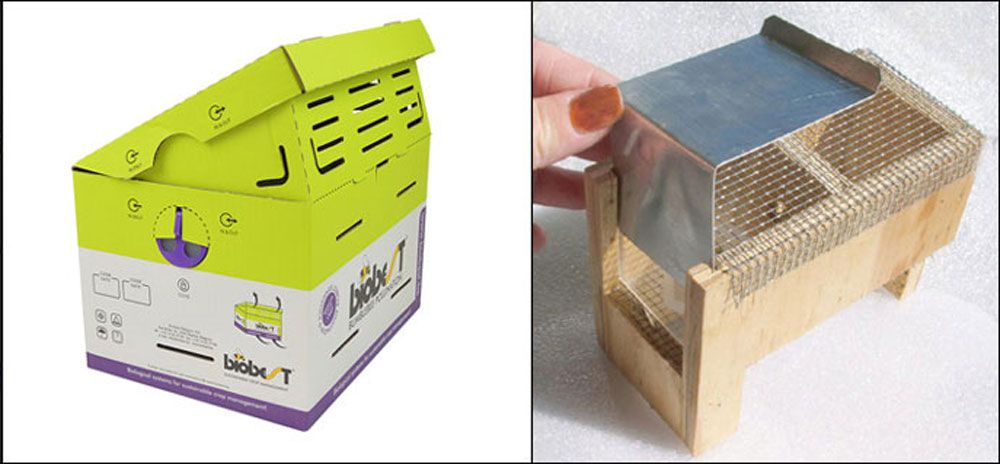
(copyright Biobestgroup.com / Sare.org)
Typical size though for backyard hives seems to be much lower. A lot seems to be dependent on the food supply. A queen in a area of sparse resources will lay less eggs and have less workers, than one in a field of plenty. So your first hive is going to be a challenge. It can be too big or too small. Don't worry, you'll learn as you go. I would start small and if you find your bees need more room, make the next year's hive bigger.
Some online sources suggest starting your new queen in a much smaller brood box. Here is also a picture of the small quarantine box you can start your new queen in. I'm not sure this is needed. If you do this, you'll need to move the queen and the brood comb to the larger permanent home later. Better I think to just quarantine the new queen in her home to start.
Here is a good tutorial on how to make a bumble bee hive with one piece of cedar fence that I like.
"How to make a bumble bee house"
(If you have good DIY skills, here is an even better bumble bee hive to build: "Bumble Bee Nesting Box - Creative Woodcraft". The design of the funnel entrance on the bottom is an interesting idea and worth experimenting with.)
Though the author of the first video doesn't have the best carpentry skills, lol. He does have a good design and a pattern for the parts, so its worth checking his video out. I'll make some suggestions on how to improve it.
Any hive you make should have some general features. It should be two chambers. A small vestibule and a larger nesting chamber. Foraging workers will stop in the vestibule to poop and to clean themselves off before entering the nesting chamber. The vestibule is also their first line of defense should other insects attack. It should have a small landing pad beneath the entrance tube and it helps to have a roof that extends past this landing pad to protect the workers during rain. Bumble bees unlike honey bees will forage in light rain, so give them some protection.
What ever you use for the entrance tube, you will want to be able to block it off. Either a cork that you can stick in it, or a cap that can go over it. This is why making it from PVC is helpful. There are caps made to fit over pipe. When you cut the hole for the entrance tube into the nesting chamber, put it about 3/4 to an inch high, so that it clears the cotton batting you will be lining the nesting chamber with later. You might pit a small piece of scrap wood under it to provide a step for the foraging workers to climb up.
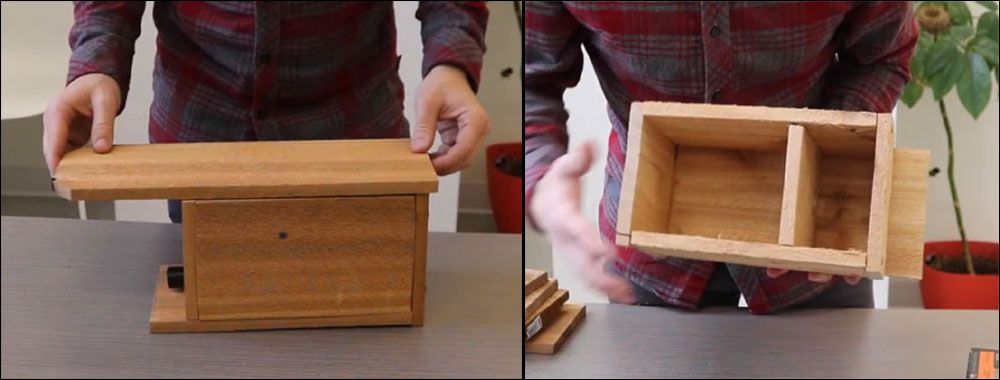
(copyright Beesinyourbackyard.com)
I don't think his vent holes are large enough. I would make them at least as large as the hole for the entrance tube is. Be sure to use a fine screen over the holes, one small enough that ants can not enter. Ants will invade the hive and steal the nectar if you let them. Glue the screen down, don't staple it. Ants and other pets can get under the screen when stapled.
You should also make the roof removable. This will allow you to check conditions in the hive. Cut a piece of clear plastic slightly smaller than the hive box, and put it under the roof. That way when you remove the roof, the bees won't fly off. You can quickly check the hive then put the roof back on without trapping and perhaps injuring any bees. Or after the bees calm down, you can remove the plastic sheet and reach in to do any cleaning if needed. When you are first establishing your new queen, you will need to feed her so access to the inside is important.
Fun fact: Queens are much bigger than their workers, and easily identified.
A flashlight with a red lens is helpful. Bees don't see the red spectrum and if you have your starter hive inside, you can turn the lights out and then use the flash light. Have a few jars handy, to catch any bees who wander out of the hive.
I would also consider painting the front of the hive a bright color. This will give the worker bees a navigation aid to return to the hive. Consider what flowers are nearest the hive and choose a different color, though avoid red.
You will want to add soft material in the nesting chamber. Cotton batting is good, as is fiberglass insulation. Or choose an organ material like dried moss, small animal bedding or dry straw. Cut a piece to fit inside the bottom of the nesting chamber and put a few smaller pieces in the corners. The new queen will make her brood comb on that but you can encourage her with a small plastic or cardboard starter nest. This is a small plastic bowl, something like the cut off top of a yogurt cup. Or maybe a few cells of a egg carton. Cut a little hole in the batting and set the starter cup in it. You can put a drop of glue on the bottom of it to affix it in place.
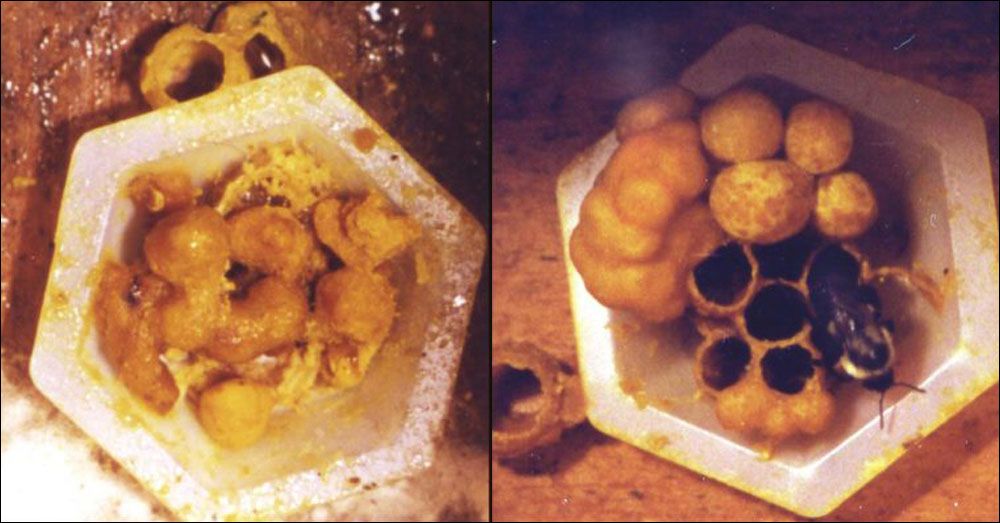
(copyright Sare.org)
As the queen is making her first comb, and laying eggs, you will want to feed her pollen balls and provide nectar. Look for and contact a local honey bee keeper for the pollen, or if that fails, buy it online. It should be as fresh as possible and is typically frozen for transport. Half a pound (0.23 kilograms) per queen and new hive is enough.
You will use this pollen to make small pea size pollen balls and place them in the nesting chamber with your new queen. This is where having the a couple of starter cups is helpful, you can drop a pollen ball into one of those. The queen will then use it to make her brood comb and feed her larvae. Replace them every few days unless you can see evidence of eggs having been laid in it. Better to have to throw a few away than to have hungry bees.
Once the larvae, which look like small maggots have hatched, provide fresh pollen equal to one third of the size of the brood cluster each day. The cluster includes the wall cells, eggs, larvae and pupae. I would put the pollen balls in the vestibule once the new workers hatch.
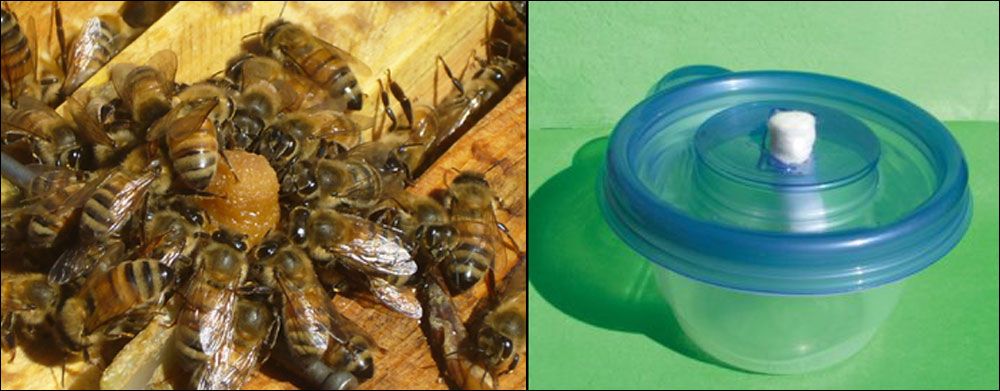
(copyright Scientificbeekeeping.com / Sare.org)
If you want, once you get a few workers, you can make small pollen patties. This just means you use a larger than pea size amount, and roll the pollen between two sheets of wax paper into a small patty. Developing colonies will need an amount of pollen roughly one third the size of the brood area each day. This is a good website for directions:
"Runamuk Acres: How to make Pollen Patties"
You will also want to have a supply of nectar for the hive. Here either a sugar water solution or humming bird nectar for feeders is ideal. Don't have open bowls though, your queen and the workers could fall in and drown. Make a small wicking bowl like this. Cotton wicks are available through dental supply stores. I would put the nectar cup in the vestibule as well. Continue to feed the hive with supplemental pollen and nectar for at least a week after you put them outside as the workers get used to foraging on their own. After this, check the hive on a regular basis (every few weeks) to see that they have enough food.
Moving Everyone Outside
Consider where you are going to have the hive once you put it outside. You want it safe from garden animals, so I'm considering mounting it on a pole about 4-5 feet off the ground and placing it among your flowers. That means attach the mount to the bottom before you put your queen inside of it. Last thing you want is for it to fall off the work bench. Or attach it to the side of a fence or tree, though this makes the hive venerable to larger predators like squirrels. You can place it on the ground but tests have shown bumble bees prefer some height. Also don't put your hive where it gets direct sunlight for long periods for it will over heat.
You want to keep your new queen inside until she's got about 10 or so workers present. If the hive seems full and crowded when you feed them, its time to get the hive outside. Once it is situated, remove the plug over the entrance tube and step back.
At this point, you should be all set. Sit back, enjoy a bottle of your favorite beverage and observe your new friends. Be sure to let us know how it works out for you please. And pictures, we love pictures.
Comments
David Trammel
Mon, 10/11/2021 - 14:22
Permalink
Beekeeper Website
This looks interesting:
https://www.openthestimga.com/
David Trammel
Sat, 11/20/2021 - 04:57
Permalink
10 Facts About Male Bumblebees
Strange facts about male bumblebees.
"DRONE BEE: 10 WEIRD FACTS THAT WILL BLOW YOUR MIND"
Everyone thinks that male praying mantis have it bad because they get their heads eaten after sex, but these poor guys are close as bad.